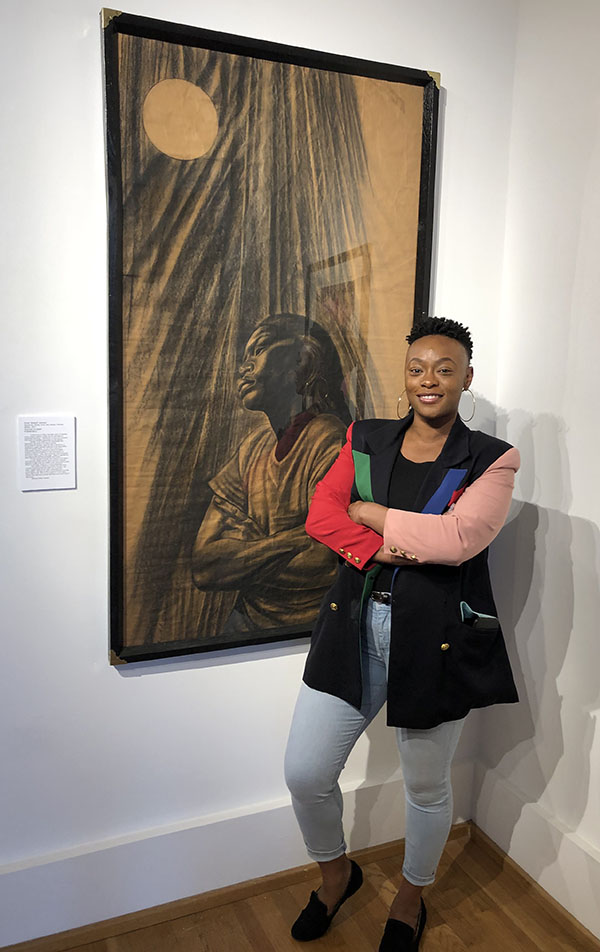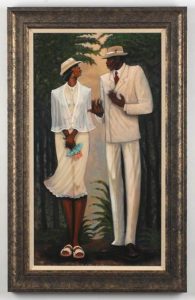
Since its establishment in 2008, the Paul R. Jones Collection of American Art at The University of Alabama continues to enable Mr. Jones’ vision of bringing art to the community and educating people of all ages in new and unique ways. Recently, one UA scholar found the Paul R. Jones Collection to be a rich resource that allowed her to expand her research, her influence, and her career.
In 2020, a UA doctoral student in cognitive psychology, Barbara-Shae Jackson, worked with Emily Bibb, curator of the Jones Collection, and Daniel White, director of the Paul R. Jones Museum, to produce an exhibition of artworks from the collection that embodied the concepts and ideas she was researching in her dissertation. Jackson was asking questions about how the aesthetic values we learn living in a white-dominated world shape our perception of what is beautiful or aesthetically pleasing – and, as a result, how our aesthetics affect the way we see ourselves in comparison to others.
Most Americans grow up in a world where “white art” – that is, art created by, about and for people of European ancestry – is the norm for aesthetic beauty. It is the art we usually learn about in school and the art we usually see in museums and galleries, and it is highly valued. Numerous studies have shown that this white standard of beauty shapes our aesthetic tastes in conscious and unconscious ways from early childhood. Indeed, our aesthetic preferences are deeply embedded in our psyches, so that, regardless of our race or ethnicity, we often believe our standards of beauty are completely natural and not learned over years of socialization.
To research this phenomenon, Jackson undertook a study that examined the perceptions and responses of Black and white viewers to art created by Black and white artists. Then she turned to the Paul R. Jones Collection to develop an exhibition using a wide variety of works in style, medium and subject, which were all “reflective of Black culture and were created by Black artists,” as she wrote in the introduction to the exhibition, titled “When They See Us, What Do They See?” Click here to read more about Jackson’s exhibition.

Even though the exhibition took place in the midst of the COVID pandemic, it was a popular show and Jackson was able to speak to some of the visitors about their responses to the art, which was one of her hopes in the project. Indeed, Jackson’s ideas and her background in psychology brought a unique vision to the show. Curator Emily Bibb expressed her excitement at having a UA scholar bring a new approach to the Jones Collection: “Every added perspective deepens our connection to these pieces. Classes in multiple disciplines have worked with the collection in a variety of ways over the years, and this exhibition shows how valuable a resource the collection continues to be to all students, even in unexpected fields.”
Jackson ultimately was awarded the UA Department of Psychology’s Outstanding Thesis Award, the College of Arts and Sciences Outstanding Thesis Award, and a dissertation award from the Southern Regional Education Board. She now holds a PhD in cognitive psychology. Dr. Jackson has presented a local TEDx Talk in which she discusses her current research as well as her own intensive experiences with art growing up in Europe.
In addition to these successes, Jackson’s research and the Jones Museum exhibition attracted the attention of the co-owner of a national firm that conducts visitor research for museums and other cultural and community institutions. As a result, she recently accepted a position in Chicago with the firm as an associate project director. In her new position conducting visitor research, Jackson reported back that she has been assigned to her “first handful of exciting projects.” She said, “I am excited to learn the language of this sector and to build relationships with my colleagues in arts and culture research as well as museum studies. Being able to continue to survey people’s experiences with art – as I had done in both my thesis and dissertation projects – and people’s perceptions of both the products themselves and the institutions that house them, is truly a gift. I am looking forward to many years of rewarding work in this industry.”
For more information about The University of Alabama’s programs in studio art and art history, visit our Degree Programs page.